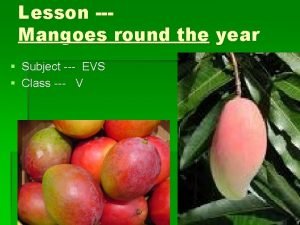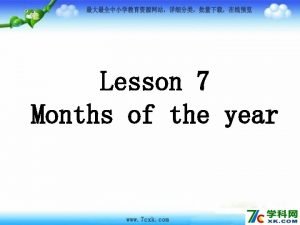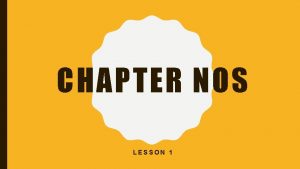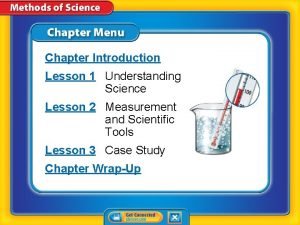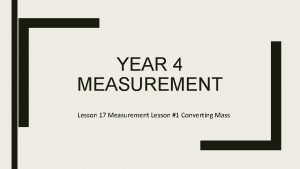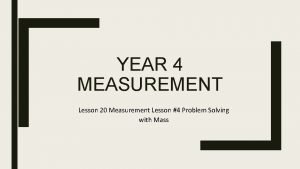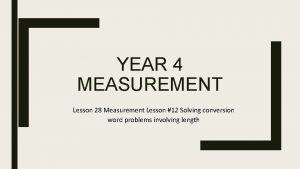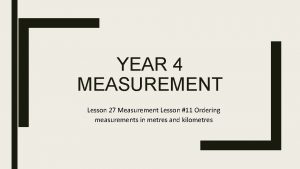YEAR 4 MEASUREMENT Lesson 21 Measurement Lesson 5








- Slides: 8

YEAR 4 MEASUREMENT Lesson 21 Measurement Lesson #5 Converting Volume

Volume can refer to the measurement of an amount of liquid. You could measure volume in millilitres (ml) or litres (l). There are 1000 millilitres (ml) for every 1 litre (l). That means these two amounts weigh the same. 1000 ml = 1 l. For example, if a bottle of Coke is 1000 millilitres and another bottle of Coke is 1 litre, they are the same amount. An item that may be 1 litre (1 l) could be a carton of orange juice or a bottle of squash. An item that may be 1 millilitre (1 ml) could be a drop of that orange juice or squash from the bottle.

Converting volume is when you change the volume to find out what it would be in a different measure. For example, changing something that is weighed in litres into millilitres. Or changing something that is weighed in millilitres into litres. To convert from millilitres into litres we need to divide by 1000. This is because every 1000 millilitres is equal to 1 millilitres. To convert from litres into millilitres we need to times by 1000. This is because every 1 litre is equal to 1000 millilitres.

To convert from millilitres into litres we need to divide by 1000. This is because every 1000 millilitres is equal to 1 litre. To convert from litres into millilitres we need to times by 1000. This is because every 1 litre is equal to 1000 millilitres. To divide by 1000, we move each digit three places to the right on a place value grid, to make the number 1000 times smaller. To multiply by 1000, we move each digit three places to the left on a place value grid, to make the number 1000 times larger. E. g. Convert 1425 millilitres into litres. To convert millilitres into litres, I need to divide by 1000, so I must move the digits three places to the right. 1425 millilitres = 1. 425 litres. Th H T O . t h th 1 4 2 5 1 . 4 2 5

To convert from millilitres into litres we need to divide by 1000. This is because every 1000 millilitres is equal to 1 litre. To convert from litres into millilitres we need to times by 1000. This is because every 1 litre is equal to 1000 millilitres. To divide by 1000, we move each digit three places to the right on a place value grid, to make the number 1000 times smaller. To multiply by 1000, we move each digit three places to the left on a place value grid, to make the number 1000 times larger. E. g. Convert 3 litres into millilitres. To convert litres into millilitres, I need to multiply by 1000, so I must move the digits three places to the left. 3 litres = 3000 millilitres. Th 3 H 0 T 0 O 3 0 . t h th

Remember, you must include a decimal point if you have any digits in the tenths column or smaller. If you hav no digits in the ones, tens or hundreds box you must think about whether you need to use a zero as a place h When moving digits to the right and left, remember they need to jump across the decimal point.

Can you convert the following from millilitres into litres? 5 millilitres 72 millilitres 290 millilitres 3061 millilitres Th H T O . t h th . Th H T O . . .

Can you convert the following from litres into millilitres? 5 litres 0. 7 litres 0. 46 litres Th H T O . t h th . Th H T O . . .
 School leaver poem
School leaver poem Lesson 9.1 intellectual advances in the first year
Lesson 9.1 intellectual advances in the first year Mangoes round the year lesson plan
Mangoes round the year lesson plan Months of the year
Months of the year Lesson outline lesson 1: understanding science answer key
Lesson outline lesson 1: understanding science answer key Understanding science lesson 1 answer key
Understanding science lesson 1 answer key Lesson 2 measurement and scientific tools
Lesson 2 measurement and scientific tools Lesson outline lesson 3 describing circuits answers
Lesson outline lesson 3 describing circuits answers Kind of fault
Kind of fault


